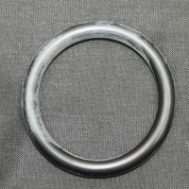Not all defects in rubber are inherently bad. At Apple Rubber, we sometimes get calls from concerned customers about a milky white substance on their molded rubber parts. While it may look like a defect to some, the material, known as bloom, is actually supposed to be there.
A great example of this is on new tires. When you buy new tires for your car, you often find a dull, film-like layer on the rubber’s surface. If you wipe it away, the tire’s black surface will be revealed. This film is made up of wax in the rubber that comes to the surface or “blooms”, providing the rubber with ozone protection.
What causes rubber to bloom?
Unintentional Blooms: Sulfur/Peroxide
Sulfur and peroxide are both used to cure the rubber during vulcanization. Sulfur is common in NBR, EPDM, and NR compounds. Peroxide is primarily used in high consistency silicone compounds. If these cures are not sufficiently used up, they can migrate to the surface of the cured part. This creates a white or gray bloom.
Intentional Blooms: Lubricants
Lubricants are added to rubber compounds to migrate to the surface, reducing friction on the rubber. Silicone oil can be added to silicones or some EPDM and NBR compounds. Because this oil is incompatible with the rubber, it will migrate to the surface over time. This creates an oily or wet feel to the surface. Erucamides or naturally derived fatty acids can be added to certain rubbers like NBR, which also migrate to the surface and lower friction. This bloom is more of a dry film compared to silicone oil. Many other types of lubricants bloom in the same way.
In some cases, which typically don’t make it to a customer, plasticizers used in the rubber formulation can migrate to the surface. This is typically in the non-polar compounds where the amount of plasticizer used is greater than the compound can accept. For example, a high acrylonitrile rubber can only accept a small amount of non-polar plasticizer. Adding too much will cause the oil to migrate to the surface. This migration is usually caught in the rubber design phase and corrected.
Why is rubber bloom helpful?
Antioxidant/Antiozonant
All rubbers, some more than others, will degrade with exposure to environmental factors such as oxygen, heat, UV rays, and ozone. These factors cause free radicals to form, which attach to the polymer chains and cleavage bonds in the rubber. This reaction can cause chain scission, which leads to the softening of the rubber or cross-linking—making the rubber harder.
Antioxidants are added to rubber formulations to scavenge these free radicals and slow the rubber’s breakdown. Antiozonants are used to block ozone from attacking the rubber.
Waxes are commonly used in rubber formulas to bloom to the surface. The wax migrates to the cured rubber surface, creating a barrier. Thus, the ozone is blocked from attacking the rubber surface. Internal antiozonants have been used that act as antioxidants. Combining these two types creates a highly protected rubber compound for high exposure ozone applications.
Removing rubber bloom
In most cases, using alcohol to wipe the rubber will remove the bloom. Limited contact with alcohol such as IPA will not deteriorate most rubber compounds. Exposure tables are based on more long term immersion. Other methods include post-curing the rubber to burn off the bloom. Typically, sulfur cured systems can be put in a circulating oven for four hours at 250°F, while peroxide cures can be placed for one to two hours at 302°F. In most cases, this will take off the bloom, but over time it can migrate back. There are formulation changes that can be made if required to help eliminate bloom as much as possible. Just keep in mind that sometimes bloom is a good thing, so you might not want to remove it!
